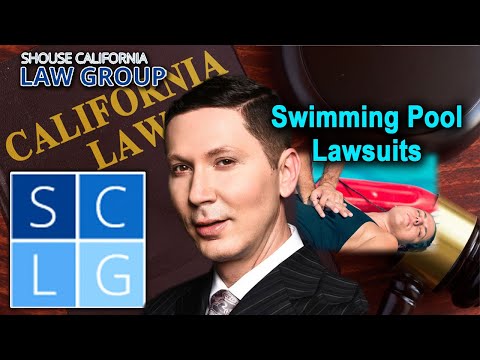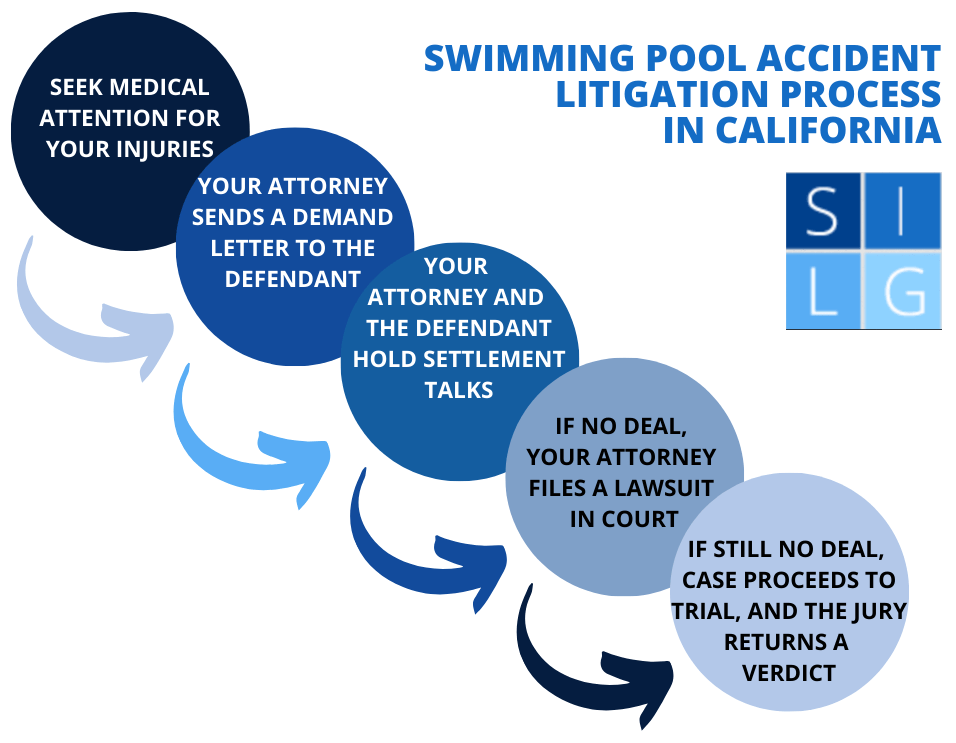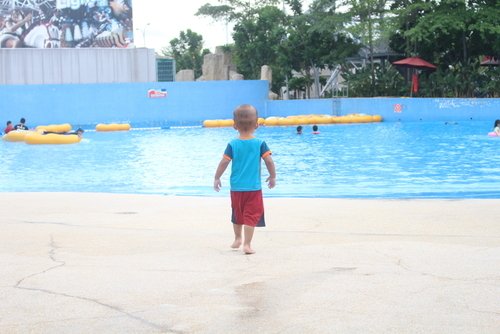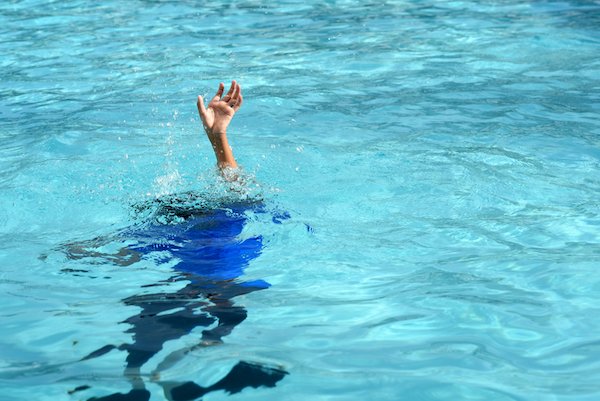
A swimming pool injury lawsuit is a personal injury claim against the owner or manager of a pool for an incident that happened at the pool. In many cases, these lawsuits are wrongful death claims filed on behalf of someone who drowned in the pool.
Many swimming pool injury lawsuits claim that the injuries were caused by someone’s negligence, or that the pool’s owner should be held accountable under the law of premises liability. These lawsuits seek compensation for your:

In this article, the swimming pool injury lawyers at the Shouse Law Office explain:
- 1. What are common types of swimming pool injuries?
- 2. How is liability different with private and public swimming pools?
- 3. Who can be held liable?
- 4. Can I bring a claim based on negligent supervision?
- 5. What compensation can a victim recover?
- 6. When can a wrongful death claim be brought?
- Additional reading
1. What are common types of swimming pool injuries?
There are a lot of ways to get hurt in a swimming pool. Some of these injuries are minor:
- Abrasions and scrapes from slipping and falling outside the pool,
- Broken bones from falling, or
- Slipping on the diving board.
However, there are also plenty of severe injuries or even fatal injuries that can happen at a swimming pool:
- Drownings,
- Near-drownings that end with permanent injuries, including brain damage, or
- Broken spine or neck from diving into a shallow part of the pool.
Altogether, these injuries are far from uncommon. According to the Centers for Disease Control (CDC), there was an average of 3,536 fatal drownings every year in the U.S. between 2005 and 2014.1 This makes unintentional drowning the fifth-leading cause of death in the United States.
One out of every five unintentional drowning victims is a child under the age of 14.2
Thousands more are victims of non-fatal accidents or near-drownings that change the course of their life.

One of the leading causes of death for young children is drowning.
2. How is liability different with private and public swimming pools?
In swimming pool injury lawsuits, the type of swimming pool is very important. There are two types:
- Private swimming pools, which are located on private property and owned and maintained by the owner of the premises, and
- Public swimming pools, which are located on public property and owned and maintained by the local government or one of its agencies, often a parks and recreation department.
While the type of swimming pool is not likely going to alter the nature or extent of the injuries, it will drastically alter how the resulting lawsuit moves forward.
Private swimming pools
The owner of a private pool can be sued for personal injury accidents that happen in their pool.
In cases where the pool owner has homeowner’s insurance that covers swimming pool accidents, the lawsuit would also be filed against the insurance company. Landlords may also be liable for injuries that occur at apartment complex pools and rental properties.
Lawsuits against private swimming pool owners are often based on premises liability. They claim that the pool’s owner had a responsibility to keep you safe on their property, but failed to uphold this responsibility.
These lawsuits include those filed against hotels or private companies for injuries sustained in their pools.
Public swimming pools
Personal injury lawsuits that stem from accidents in a public swimming pool are far more complex because they are filed against a public entity. Because the lawsuit would recover compensation from the local government, which is funded by taxpayers, there are numerous procedural hurdles that complicate the lawsuit.
Additionally, there are often caps on the amount of compensation that the lawsuit can win.
Many lawsuits for injuries that happen in public swimming pools claim that the injury was caused by negligent supervision. They frequently argue that the lifeguards failed to keep people safe, and this led to the injury.
3. Who can be held liable?
Many swimming pool injury lawsuits claim that the owner of the pool had a responsibility to keep you safe, but failed to do so and should be held accountable under premises liability.
In most states, including California, property owners are required to keep their property, including their swimming pool, in a reasonably safe condition. Failing to do so, and failing to warn others about the dangers that might not be apparent, can make those property owners accountable to you for the injuries you sustain in or around the swimming pool.
In many states, the major factor in determining whether the pool and premises were kept in a reasonably safe condition is how foreseeable it was for you to be there. The laws in these states recognize three types of visitors, each of whom is entitled to a safer environment:
- Trespassers are people who are on the premises without the permission or invitation of the owner. Property owners only have a duty to not willfully cause a trespasser harm.
- Licensees are people who are on the property for their own purposes and with the express or implied consent of the owner. Property owners cannot willfully cause a licensee harm, and have to warn a licensee of non-apparent dangers.
- Invitees are people who are on the property with the owner’s invitation and for the owner’s financial benefit. Property owners have to look for dangerous conditions and either fix them or warn invitees about them.
Example: 21-year-old Paul jumps over his neighbor’s fence and into their pool to cool off on a hot day. He would be a trespasser, so if he got a cramp while in the pool and nearly drowns, the owner would not be held liable.
Example: 5-year-old Evie is running around the pool. The deck is made of wood and very clearly turns a dark color and gets slippery when it is wet. However, there are no warning signs. Evie does not recognize the danger and loses her footing when she changes direction at the corner of the pool and hits a wet spot. She falls and breaks her arm on the side of the pool and gets a large cut on her knee that requires stitches.
If Evie was at a neighbor’s pool for their Fourth of July party, she would be a licensee and the owner might not be held liable.
However, if Evie was at a hotel with her family for vacation, she would be an invitee and the hotel could be held liable for not fixing or warning about this danger.
In California, though, premises liability law does not rely strictly on these categories. Instead, premises liability in California looks to all of the circumstances, in addition to your intentions, to determine whether reasonable care was taken by the property owner to keep you safe.3 Some of these circumstances include:
- Whether there was a fence around the pool,
- Whether the pool was an above-ground pool or below-ground pool,
- The presence of locks on any gates allowing access to the pool, and
- A history of people gaining access to the pool in the past.
Special rules for children trespassers
Many states have special rules for children who would be considered trespassers under their premises liability laws. Some other states, including California, merely count the age and maturity of a young victim as a factor in whether the property owner should be held liable for their swimming pool injury.
The special premises liability rule for trespassing children is known as the attractive nuisance doctrine. This rule makes property owners liable to injured children who have trespassed onto their property to explore something that could reasonably induce a child to trespass.
The attractive nuisance doctrine is especially important for swimming pool injury lawsuits because swimming pools are among the attractive nuisances that could lead to the owner’s liability.4
4. Can I bring a claim based on negligent supervision?
Some swimming pool injury lawsuits claim that the injuries happened because the pool was negligently supervised.
Claims of negligent supervision are most common when the injuries occurred in a public pool or park, or where there are lifeguards to keep people safe. Swimming pool injury lawsuits based on negligent supervision claim that these lifeguards either failed to do their job, or that there was no sign that lifeguards were off duty.
Example: Carl is playing with his children in the water zone of a local amusement park. He slips, falls, and hits his head. Even though the water is only ankle-deep, his mouth and nose are underwater so he begins to drown. Staff members at the amusement park do not notice that Carl is drowning for nearly three minutes. While they manage to save his life, Carl suffers extensive brain damage from a prolonged period without oxygen. The amusement park may be liable for Carl’s injuries based on negligent supervision.

Near-drowning accidents can cause brain injuries requiring lifelong home health care.
5. What compensation can a victim recover?
If you have suffered a swimming pool injury, you can be entitled to compensation from the person or people who were responsible for your injuries.
This compensation can cover:
- Past medical expenses you have already incurred,
- The cost of future care, including long-term in-home care (common in cases with sustained brain damage),
- Wages and other forms of income that have been lost during the recovery process,
- Inability to earn a living in the future,
- Pain and suffering, and
- Loss of companionship for your family.
6. When can a wrongful death claim be brought?
Where your family member died in a pool accident, you have the option of filing a wrongful death lawsuit on the victim’s behalf.
Each state has its own statute that governs how wrongful death lawsuits can proceed. Because the goal is to compensate you rather than the victim, directly, many of wrongful death statutes provide different kinds of compensation for successful claims. Some of the most common types of compensation recoverable in a wrongful death claim include:
- Funeral expenses,
- Loss of consortium and companionship, and
- Loss of financial security and the victim’s missed income.
Additional resources
For swimming safety tips, refer to the following:
- Drowning Prevention & Facts – The American Red Cross’s page on drowning prevention tips and facts.
- Safety Tips – Safe Kids Worldwide’s page with drowning prevention tips for parents and caregivers.
- Drowning Facts – Centers for Disease Control and Prevention (CDC) fact sheet on unintentional drownings.
- Water Safety for Parents – Johns Hopkins Medicine’s overview of drowning causes, risk factors, and prevention.
- A Review of Interventions for Drowning Prevention Among Adults – Scholarly article in Journal of Community Health.
References:
- Centers for Disease Control and Prevention, “National Center for Injury Prevention and Control: Web-based Injury Statistics Query and Reporting System (WISQARS).”
- See note 1.
- Ann M. v. Pacific Plaza Shopping Center (1993) 6 Cal.4th 666, 863 P.2d 207 (“In this state, duties are no longer imposed on an occupier of land solely on the basis of rigid classifications of trespasser, licensee, and invitee. The purpose of plaintiff’s presence on the land is not determinative. We have recognized, however, that this purpose may have some bearing upon the liability issue. This purpose therefore must be considered along with other factors weighing for and against the imposition of a duty on the landowner.”)
- See, for example, Gregory v. Johnson, 289 S.E.2d 232 (1982).
